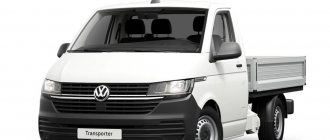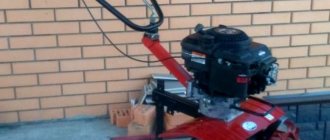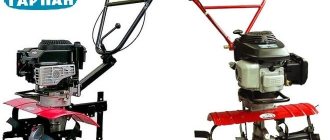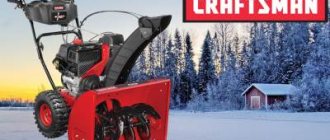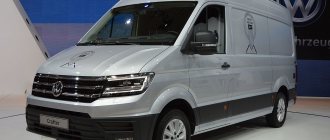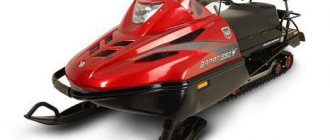Volkswagen Transporter, a car designed for transportation
The Volkswagen Transporter is a practical, pleasant to drive and convenient minivan in many respects, like any other passenger car, with a wide range of applications. It has different equipment with its various variations, and is also in many ways similar to the version of the BlueMotion car model, which provides its owner, along with the above-mentioned advantages, also with low fuel consumption.
| Pros: | Minuses: |
| Wide selection of body sizes and types, good and convenient handling | Noisy inside (not very high quality sound insulation), relatively expensive |
The fifth generation of Volkswagen Transporter cars, or as this version is designated, T5, is an excellent and long-proven light-duty van with a fairly satisfactory choice of two body lengths and three roof heights. This minivan is produced and supplied to the market with only one type of engine, so there is nothing to choose from in terms of volume. This is exclusively a 2.0-liter TDI diesel engine equipped with a common rail system and that’s all. But this one engine implies five output powers, for example, from low-power 84, 102 and 115 power versions with front-wheel drive, the power of which is distributed and supplied through a five-speed manual transmission, to more productive 140-horsepower and 180-horsepower car models received a six-speed manual transmission as standard, as well as an excellent (judging by reviews) VW DSG dual-clutch gearbox as an optional option.
Important to know: Diesel engine overrun. The essence of the phenomenon, how to avoid it and how to stop it?
The 4MOTION all-wheel drive system is also available on more powerful versions of the car. Additionally, we can add that this technologically advanced system “BlueMotion Technology” makes emissions of harmful substances, i.e. nitrogen oxide and CO2, on the 84 and 115-horsepower versions are much lower than the required level and at the same time improves the fuel consumption of the car. For example, the same fuel consumption for the 115-horsepower Transporter BlueMotion car model is promised to be around 5.23 liters with emissions of up to 166 g/km.
This Transporter is also distinguished by the large number of bodies offered by the manufacturer and their different types. Each of the body options is created to solve its own specific goals and is thought out literally to the smallest detail, so buyers have plenty to choose from. The client will be satisfied.
The Volkswagen Transporter Kombi offers a second row of folding seats, allowing owners to combine the vehicle for transporting people and cargo.
Transporter Shuttle is a nine-seater vehicle for transporting passengers.
The latest version is the VW Camper, called California. This van is designed specifically for recreational camping or travel. This is a whole house on wheels which is based on the same Transporter car model. However, it is known that handy car owners often make their motorhomes from the same basic version of a cargo minivan. Perhaps the latter simply do not have the funds to buy a ready-made top version, but they have ideas in their heads and decent life experience for their implementation.
There are also versions of Transporter cars with open bodies, which allow buyers to ideally choose a car for their work needs, as well as for high loads. As a result, there are options on the market with two-door chassis, four doors and various onboard variations.
The specification of the Sportline version of the Transporter and Transporter Kombi was created for private entrepreneurs and small companies involved in transportation. These two variations are quite strong rivals for cars such as the Mercedes Vito Sport X and Ford Transit Sport Van.
Volkswagen T6 2022
The VT6 was first presented to the general public at the end of 2015 at a car exhibition in Amsterdam, and in 2022 its sales began in Russia.
In 2022, the Volkswagen T6 began to be sold in Russia
Technical innovations
Changes in the 2022 model affected most components and parts of the car. First of all, the appearance has changed:
- the shape of the radiator grille has changed;
- the shape of the front and rear headlights has changed;
- The shape of the front and rear bumpers has changed.
The salon has become more ergonomic:
- inserts in body color appeared on the front panel;
- The cabin has become more spacious - even the tallest driver will feel comfortable behind the wheel.
The interior and dashboard of the Volkswagen T6 have become more comfortable
The car is available with two wheelbase options - 3000 and 3400 mm. The choice of engines has expanded. The buyer can choose from four diesel and two petrol units with torque from 1400 to 2400 rpm and power outputs of 82, 101, 152 and 204 hp. With. In addition, you can install a five- or six-speed manual or seven-speed DSG automatic gearbox.
New systems and options
In VT6 it became possible to equip the car with the following new systems and options:
- electronic Front Assist system, which helps the driver control the distance in front of and behind the car;
Front Assist helps the driver control the distance - City Emergency Braking function, which provides emergency braking in an emergency;
- the presence of side airbags and curtain airbags, which significantly increases the safety of passengers;
- a cruise control system, installed upon request of the buyer and operating at speeds from 0 to 150 km/h;
- the Park Assist system for facilitating parking, which allows you to park a minibus parallel or perpendicular without driver assistance and is a kind of “parking autopilot”.
Advantages and disadvantages of Volkswagen T6
The Volkswagen T6 model turned out to be quite successful. Experts consider the following to be the main advantages.
- Volkswagen engineers took into account the wishes of car enthusiasts. All the advantages of the VT5 were not only preserved in the new model, but were also supplemented with modern electronics, which significantly makes life easier for the city driver.
- A wide range of VT6 versions allows the buyer to choose a minibus according to their needs and capabilities. Depending on the configuration, the price varies from 1,300 to 2,265 thousand rubles.
- Compared to the previous model, fuel consumption has noticeably decreased. With a power comparable to the VT5, it has become 2.5 liters less (per 100 km) in urban conditions and 4 liters less when driving on the highway.
Of course, VT6 also has disadvantages, but there are very few of them:
- plastic inserts matching the body color on the dashboard do not always look harmonious, especially if the body is quite bright;
Blue inserts do not go well with the black panel of the Volkswagen T6 - The ground clearance decreased and became only 165 mm, which is a significant disadvantage for domestic roads.
Reviews from Volkswagen Transporter owners
Due to the addition to the family, we decided to exchange our Polo for a Transporter. Looking ahead, I will say that we were very pleased with this reliable and comfortable minivan. The transporter is perfect for long trips with the whole family. On a long trip with small children, everyone was happy and comfortable. Despite our Russian roads, the car copes with its duties perfectly. The suspension is energy-intensive. Very comfortable, soft and comfortable seats. The climate control works great. There is a lot of space for transporting things. The car's handling evokes only positive emotions. The six-speed gearbox has proven itself to be excellent. Despite its dimensions, the car feels one hundred percent. Maneuverability is excellent even when fully loaded. The car consumes fuel very economically, and this undoubtedly encourages long trips.
Vasya
https://review.am.ru/review-volkswagen—transporter—6e249d4/
Good afternoon, today I wanted to talk about the Volkswagen Transporter diesel 102 l/s. Mechanics. The body of a 9-seater is an ordinary normal minibus. There are no complaints about the body. The interior panel is conveniently located, everything is clearly visible, everything is in its place. I repeat, 9 seats are located quite conveniently, it couldn’t have worked out better. The noise insulation is of course rather weak, the body whistles and creaks a little on bumps, but this can be easily eliminated; lubricate the hinges and rubber bands of the doors and all rubbing surfaces with a bucket and the problem is solved. The stove, of course, can’t cope in cold weather, but this can also be solved by installing an additional one and that’s it. There is air conditioning, which is important. The engine is not located conveniently for maintenance, but there is no other way to insert it there. Moreover, if not, then you need to install Webasto, otherwise a problem with the plant will arise in winter and the engine will not strain in cold weather. There is enough horsepower in combination with the mechanics. The chassis is tolerable, it has its own little problems, but they can be fixed. Moreover, there are a lot of conversions from vans to minibuses, so be careful, because the car is in demand.
zaha
https://otzovik.com/review_728607.html
Very good car! I drove this Volkswagen for several years and never regretted my choice. The van is very nice, roomy, comfortable, and most importantly, the price is not that high. Reviews from owners are mostly positive, and I absolutely agree with all of them. I hope to drive this car for a long time. I would recommend this car for those involved in agriculture and cargo transportation. He eats a little diesel fuel, about 8 liters. per hundred.
https://www.autonavigator.ru/reviews/Volkswagen/Transporter/34405.html
Fuel consumption and operating costs of the Volkswagen Transporter
Each Transporter variant is powered by a 2.0-litre diesel engine, depending on which of the five versions you choose. This “2 liter base” can be quite impressive and effective. The proposed “BlueMotion Technology” package can, in addition to caring for the environment, reduce the vehicle’s fuel consumption (we gave an example of these models and their power above, namely: 84 and 115-horsepower engines). This improvement is due to the installation of other tires with low rolling resistance and cruise control, as well as that new engine technology - “Start-Stop”, which has taken root not only on passenger cars, but also on commercial vehicles. In neutral, the motionless Transporter minivan stands with the engine turned off, but as soon as the driver presses the clutch pedal, the engine immediately starts up. Fuel savings are obvious for everyone and there is no harm to the engine or the starter.
Important to know: Volkswagen Tiguan. What you need to know before buying
And all this with care for the user. For drivers of commercial vans, fuel consumption is always a big priority; in the daily operation of the vehicle, this nuance (issue) is at the top of the list (list).
Evolution and brief overview of the Volkswagen Transporter model range
The first Volkswagen Transporter (VT) minibus rolled off the production line in 1950.
Volkswagen T1
The first Volkswagen T1 was released in the city of Wolfsburg. It was a rear-wheel drive minibus with a carrying capacity of up to 850 kg. It could carry eight people and was produced from 1950 to 1966. The dimensions of the VT1 were 4505x1720x2040 mm, and the wheelbase was 2400 mm. The minibus with a four-speed manual gearbox was equipped with three engines of 1.1, 1.2 and 1.5 liters.
The first Volkswagen T1 minibus rolled off the assembly line in 1950
Volkswagen T2
The first VT2 rolled off the assembly line at the Hannover plant in 1967. It was an improved version of its predecessor. The cabin has become more comfortable, and the windshield has become solid. The design of the rear suspension has changed, which has become noticeably more reliable. The engine cooling remained air-cooled, but the volume increased. The VT2 was equipped with four types of power units with a volume of 1.6, 1.7, 1.8 and 2.0 liters. The buyer was offered a choice of a four-speed manual or three-speed automatic gearbox. The dimensions and wheelbase have not changed.
Volkswagen T2 received full wind glass and improved suspension
Volkswagen T3
Production of the VT3 began in 1979. It was the last model to feature a rear-mounted, air-cooled engine. The dimensions of the car have changed. They were 4569x1844x1928 mm, and the wheelbase increased to 2461 mm. In addition, the car became heavier by 60 kg. The model range was equipped with gasoline engines with a volume of 1.6 to 2.6 liters and diesel engines with a volume of 1.6 and 1.7 liters. Two manual transmission options were offered (five-speed and four-speed). It was also possible to install a three-speed automatic transmission.
Volkswagen T3 - the last air-cooled bus
Volkswagen T4
The VT4, whose production began in 1990, differed from its predecessors not only in its front-engine layout, but also in its front-wheel drive. The rear suspension has become more compact and has an additional pair of springs. As a result, not only the loading height of the vehicle was reduced, but also the load on the floor. The load capacity of the VT4 reached 1105 kg. Dimensions increased to 4707x1840x1940 mm, and the wheelbase size increased to 2920 mm. The minibus was equipped with diesel units with a volume of 2.4 and 2.5 liters, and the latter was equipped with a turbocharger. Versions with a four-speed automatic and five-speed manual transmission were offered. VT4 became the best-selling Volkswagen minibus and was sold in almost all European countries, including Russia, until 2003.
The Volkswagen T4 differed from its predecessors not only in its front engine, but also in its front-wheel drive.
Volkswagen T5
Production of the VT5 began in 2003. As in the previous model, the engine location was front, transverse. The VT5 was produced in front-wheel drive and all-wheel drive versions and was equipped with 1.9, 2.0 and 2.5 liter diesel engines with turbochargers. The car was equipped with a five- and six-speed manual transmission or a six-speed automatic transmission, and the gear shift lever was located on the front panel to the right of the steering column. The dimensions of the VT5 were 4892x1904x1935 mm, and the wheelbase was 3000 mm. VT5 is still in production and is in great demand both in Europe and in Russia.
The Volkswagen T5 is still in production and is in great demand among European and Russian buyers.
Advantages of the all-wheel drive Volkswagen Transporter
Starting from the fourth generation, the VT began to be produced in both all-wheel drive and front-wheel drive versions. The advantages of all-wheel drive include:
- High reliability and good controllability.
- Increased cross-country ability. The wheels of the all-wheel drive VT slip less. The quality of the road surface does not have a big impact on the movement of the car.
- Automation. All-wheel drive on the VT engages automatically as needed. Most of the time, the minibus uses only one axle, which, in turn, leads to significant fuel savings.
Load space and practicality of VW Transporter cargo vans
This minivan offers two body lengths and three roof heights. Thus, the Transporter practically coincides with the largest Caddy car and the smallest Crafter car in terms of its internal volume and load, with a volume capacity from 5.8 m3 to 9.3 m3. In addition, in addition to the Kombi and minibus versions, this van is available as a single or double cab with chassis, which allows you to expand its range of use. For example, you can transport bulk cargo with the possibility of side unloading.
The regular Transporter minivan van is compact enough to drive in the city. A certain “squareness” and well-thought-out dimensions allow this car model with a short wheelbase to place 2 (two) Euro pallets in its belly at once, and the elongated models of this car are able to take on board even 3 (three) Euro pallets. The low height (566 mm) of the floor on the car is similar to that of the Ford Transit Custom (534 - 583 mm) and Mercedes Vito (556 - 562 mm).
Surprisingly, this is true; the loading height of the all-wheel drive version of the Transporte 4MOTION model is no higher than that of the same single-wheel drive version. However, these variations are capable of carrying a smaller payload. However, buyers of these minivans who chose the all-wheel drive version will happily sacrifice a smaller payload to be able to overcome fairly severe off-road conditions. A 4x4 van is capable of driving in bad weather along a country road or over difficult terrain; it will not let you down or disrupt your planned work with unexpected downtime.
Access to the load space is easy, thanks to two rear doors or an optional single rear door on the Kombi. Plus, loading itself is greatly simplified using the same sliding side door. There are six fastening rings in the floor of the car (eight rings in models with a long wheelbase), plus, half the height of the walls is protected by a fiberboard lining - the walls of the van itself will be more intact and will not be damaged.
This Transporter can carry from 740 to 1,340 kg of weight, depending on the configuration. Although it's worth noting here that the T30 Kombi vans with 4MOTION have a payload of less than 1000kg.
Volkswagen Transporter T5 (2003-2015)
VW minibuses are in steady demand in both the primary and secondary markets - these vehicles are among the most popular in their segment. What is the secret of the popularity of T5 models?
Story
VOLKSWAGEN TRANSPORTER with the TK index was released in mid-1979. Even then, it was spoiled by the attention of buyers, even despite the original design with rear and drive wheels. The car remained on the assembly line until 1992.
The fourth generation VOLKSWAGEN TRANSPORTER T4 appeared in 1990. The minivan was revolutionary both externally and technically. And on the secondary market it is still very popular.
VOLKSWAGEN TRANSPORTER fifth generation T5 2003-2009
Modifications
Like its predecessor, the VW T5 family is represented by a number of modifications - commercial Transporter with a cargo body and single and double cabs, Transporter minibuses in cargo and cargo-passenger versions, Caravelle (passenger only), stuffed Multivan, California camping vans, which are rare among us, with a furnished interior and lift roof, and for off-road conquerors - Multivan PanAmericana with all-wheel drive transmission, increased ground clearance and easy-to-clean interior trim.
The lion's share of the car market is occupied by cars of the Transporter family. They are often converted from cargo versions into passenger ones: customs clearance for “trucks” is much cheaper, and the price of the vehicles themselves is initially more affordable compared to the Caravelle/Multivan. Enterprising domestic sellers often pass off “homemade” products as expensive modifications of the Caravelle or Multivan and set the corresponding price. You can determine the original version by the VIN number of the body: the number “1” in the third position after the letters VW means that this is a cargo version, and “2” is a passenger version.
Body And Interior
On older cars, you should check the side sliding doors - over time, the roller-type hinges wear out, which is why the doors do not close well and knock on uneven surfaces. Prestigious Multivans were equipped with rear and side door closers, but their closing sensors fail over time.
The multifunctional interior of the T5 provides ample transformation possibilities, which makes the car universal. The functionality of these machines is increased by the presence of two wheelbase options and three roof heights. Most often, the back door is solid and lifting. Hinged doors are less common (on cargo versions). Even the smallest modifications have a cargo compartment volume of 5800 liters, and the “long” ones with a high roof have as much as 9300 liters!
Engine
In T5 turbodiesels, you need to use only oils that have VW approvals: for a 1.9-liter engine - 50501 or 50700 (with a particulate filter), and for a 2.5-liter engine - 50601. Otherwise, increased wear of cylinder head parts (camshafts and their beds, hydraulic compensators, etc.). 15–20 thousand km on the “left” oil is enough to damage the cylinder head.
The timing belts of the 1.9 liter TDI and 2.0 liter petrol engines are equipped with a belt, which is changed along with the rollers every 120 and 90 thousand km, respectively. The timing belt of the 2.5 TDI engine has a gear drive, and the attachments have the same drive. By the mileage of 150 thousand km, the damper couplings of the generator and air conditioning compressor may fail (they are cut off), but this does not lead to serious problems. The timing belt of the 3.2 liter engine is driven by a chain, which can stretch out by 100–150 thousand km, and its hydraulic tensioner can wear out.
By 100 thousand km in turbodiesels, the fastening of the intercooler pipes weakens, problems arise in the vacuum valves of the turbine control, after 150 thousand km the booster and tandem pumps may fail, the sealing wheels of the pump injectors may lose their tightness, due to which diesel fuel gets into the oil system . In the 2.5 liter engine, the oil cooler lost its tightness (lubricant enters the cooling system), and the pump leaked after 100 thousand km (antifreeze gets into the oil).
Among gasoline engines, the most problem-free is the 2.0-liter. In the 3.2 liter, in addition to timing faults, failure of individual ignition coils was noted. It is also the most voracious (in the city – about 17.0 liters per “hundred”), although it provides the best dynamics – 10.5 s to 100 km/h (2.5 liter TDI 130/175 hp – 15, 3 s and 12.2 s respectively).
Weak points of the car
By the mileage of 100 thousand km, wear was noted on the fastenings of the intercooler pipes (all TDI).
In versions with a manual transmission, especially when driving with overloads, after 100 thousand km the damper flywheel may fail (a knocking noise appears when starting to move and changing gears).
In a 2.5 TDI engine, after a mileage of 150 thousand km, the damper couplings of the generator and air conditioning compressor may fail.
Transmission
Trouble-free automatic transmission Most T5s are front-wheel drive. The 4Motion all-wheel drive transmission is more common in the Multivan. In general, 4Motion has proven itself to be reliable, except that with long runs (about 250 thousand km), the outboard bearings of the driveshaft may wear out (a characteristic hum can be heard while driving). However, at specialized service stations they are changed and the shafts are balanced. T5 were equipped with mechanical and automatic torque converter gearboxes. “Automatic” is more reliable, but in “mechanics”, with runs of about 150 thousand km, the splined joints can break, and after 100 thousand km, the damper flywheel fails. In the clutch of 2.5-liter versions, the slave cylinder sometimes leaks. The oil in the manual transmission does not change, but in the automatic transmission it requires replacement along with the filter every 100 thousand km.
Suspension
The T5 has an independent McPherson suspension at the front and a double wishbone at the rear. There are anti-roll bars at the front and rear, which allows you to confidently stay on the road even during sharp maneuvers. The suspension is well-tuned, with good energy capacity (varies in rigidity depending on the modification). After 60 thousand km, the consumables of both stabilizers are changed, up to 90 thousand km the rear silent blocks of the front levers, support bearings of the struts and ball joints are used. The “rubber bands” of the rear suspension arms last about 120 thousand km, shock absorbers and front silent blocks of the front arms last 100–150 thousand km.
Reliability and safety of Volkswagen Transporter
Electronic stability control is standard on all versions of the Transporter. This system works in conjunction with the ABS and TCS-equipped braking system to better control traction, thereby reducing the chance of the van itself slipping or skidding.
See also: Automakers reduce vehicle weight
The greatest driving safety, of course, is provided by the 4MOTION version of the car with all-wheel drive, although this option is not cheap, it costs approximately 225 thousand rubles (for VW minibuses) and is installed on cars with engine power of 140 and 180 hp. Ultimately, this car with this system provides the owner with increased safety and good off-road capabilities, with a logical increase in fuel consumption.
All of the above-mentioned car models are supplied with: -daytime running lights, driver and passenger airbags and central locking. Also included as standard is the Hill Hold system, which holds the service (main) brake for a few seconds before starting to allow the driver to press the gas pedal and move off safely. The owner of this Transporter is unlikely to be aware of the problems associated with its repair. This VW camper is simply reliable. It is not uncommon for such cars to travel 800 thousand and 1,000,000 million kilometers without any serious breakdowns or engine overhauls.
In addition, when selling this van you will not lose much in price; used Transporters are well valued on the used car market.
Driving and performance of the Volkswagen Transporter
Even the 84-horsepower Transporter, which is modest in power, is very pleasant to drive; this has been noted more than once by its owners on the forums. It should be noted that the van only improves its driving performance with the next increase in engine power. Indeed, in fact, the 180-horsepower BiTDi model with a twin-turbo engine has so much torque and power that in an empty (unloaded) car the driver better beware of suddenly pressing the gas pedal, turning the engine a little (gas) and before you know it, you'll fly under a security camera while speeding.
The manual transmissions on these RVs are excellent, although only a five-speed was available on the entry-level trims of this model. More powerful vans naturally get a six-speed manual transmission. But the most convenient and useful gearbox to use is certainly the seven-speed automated manual DSG. According to most van owners, using it is a pleasure. Therefore, ideally, it should definitely be on the car, although it will add significant costs to the owner in the amount of 143 thousand rubles to the total cost of the van.
Cabin and interior Transporter
Like all VW car models, this Transporter is made reliably and with high quality inside, the cabin is trimmed with branded plastic, with fairly hard but very comfortable seats. There is plenty of storage space in the cabin, including space under the double passenger seat. Mid-price Transporter minivans are usually equipped with a standard solid partition. On entry-level models it comes as an additional option, which the van owner would still want to order, as this will significantly reduce the noise level in the cabin from the cargo compartment and naturally increase safety. Good luck and happy shopping!
